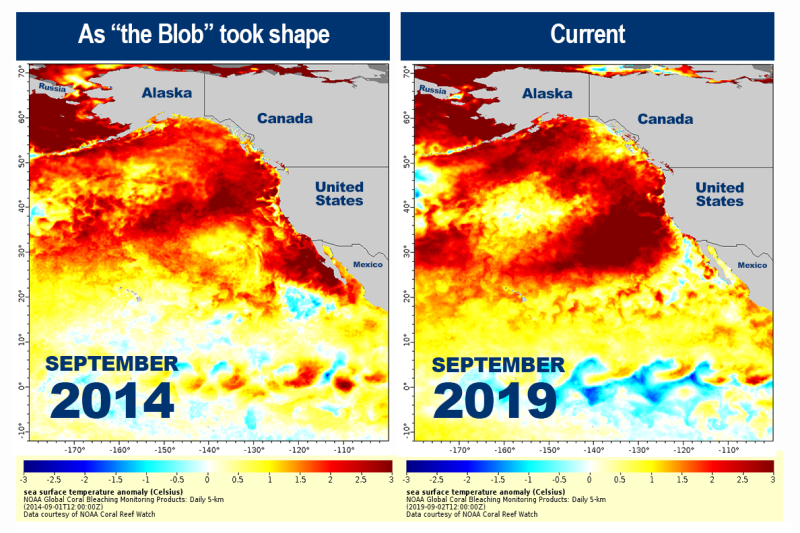2022 is a good year for whales in the Northeast Pacific. This year we are experiencing a La Niña condition, where strong Northwest winds blow along the west coast pushing waves and surface currents southwards. La Niña is the cold water phase of the tropical Pacific Ocean temperature pattern known as the El Niño-Southern Oscillation (ENSO).
El Niño and La Niña are the warm and cool phases of a recurring climate pattern across the tropical Pacific known as the El Niño-Southern Oscillation, or “ENSO” for short. The pattern shifts back and forth irregularly every two to seven years, and each phase triggers predictable disruptions of temperature, precipitation. These changes disrupt the large-scale air movements in the tropics, triggering a cascade of global side effects. These oceanic patterns impact large-scale jet stream patterns in the atmosphere which in turn affect winds, temperature and seasonal climate. This in turn, can have dramatic impacts upon coastal productivity.
When the wind blows parallel to a coastline, surface waters are directed offshore by the rotation of the Earth, by a force known as the Coriolis effect. This combination of vectors creates a vacuum at the surface and seawater is drawn from below to replace the water that has been pushed away. The upward movement of this deep, colder water is called upwelling.
The deeper water that rises to the surface during upwelling is also rich in nutrients generated by dead sinking sea life from the surface.These nutrients are like pouring Miracle-Gro on a garden, fertilizing the surface waters, and providing rich nourishment for the uni-cellular plants that fix sunlight known as phytoplankton. As primary producers, phytoplankton serve as the ultimate energy base in the ocean for large animal populations higher in the food chain, providing food for fish, marine mammals, seabirds, and other critters.
Coastal upwelling ecosystems, such as along the west coast of the United States, are some of the most productive ecosystems in the world. These ecosystems, super charged by upwelling support many of the world’s most important fisheries. Although coastal upwelling regions account for only one percent of the ocean surface, they contribute approximately 50 percent of the world’s fisheries landings.
Upwelling can also play an important role in the distribution and movements of larger marine animals, especially filter feeding animals like humpback whales and basking sharks. Most marine fish and invertebrates produce microscopic larvae which, depending on the species, may drift in the water for weeks or months as they develop. For adult marine creatures that live in shallow waters nearshore, upwelling that moves surface water offshore can potentially move drifting larvae long distances away from their natural habitat, thus reducing chances for survival.

In El Nino years where the winds are weaker and surface waters are warmer the gradient of surface pressures causing wind patterns lessens, and productivity decreases. This decline in resources can lead to starvation of coastal animals like sea lions that benefit schooling fishes that feed on plankton.
In 2014 and again in 2019, a warm expanse of seawater off the West Coast stretching from Alaska south to California disrupted the West Coast marine ecosystem.
Termed “the Blob,” this marine heatwave disrupted salmon runs, caused starvation among many marine mammals and caused a shift in the seasonal whale migration.
Global disruption in weather patterns and sea surface temperatures caused by climate change may increase the occurrence of marine heatwaves, and warmer sea surface temperatures that will impact productivity and our California coastal economy. Yet for now, this year promises a productive year with an abundance of leviathans and other migratory species that visit our National Marine Sanctuary in the Gulf of the Farallones.
Join Shark Stewards on our fall Sharktober expeditions watching whales, seeing seabirds and seeking great white sharks near the Farallon Islands.